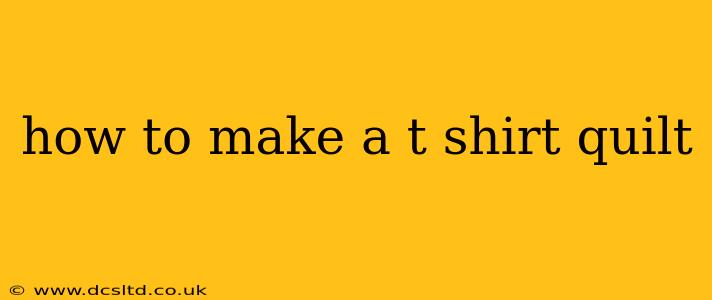Turning your cherished collection of t-shirts into a cozy and personalized quilt is a rewarding project. This comprehensive guide will walk you through the process, from selecting your shirts to adding the final touches. Whether you're a seasoned quilter or a complete beginner, this guide will empower you to create a unique and cherished heirloom.
Choosing Your T-Shirts and Preparing Them
Before you even start thinking about stitching, the first step is selecting your t-shirts. Consider the following:
-
Shirt Selection: Choose shirts with sentimental value – concert tees, vacation memories, family reunions – anything that holds special meaning. Aim for a variety of colors and designs for a visually appealing quilt. You'll need enough shirts to create the desired quilt size. A lap quilt typically requires 12-18 shirts, while a larger throw might need 20-30 or more.
-
Washing and Ironing: Before cutting, wash and dry all your shirts. This crucial step pre-shrinks the fabric, preventing your finished quilt from shrinking later. After washing, iron each shirt carefully to remove wrinkles and ensure clean, crisp cuts.
-
Cutting Your Squares: Decide on the size of your squares. Standard sizes range from 10" to 12". Use a rotary cutter and mat for precise cuts. This is much faster and easier than using scissors, especially for multiple shirts. If your shirts have designs that you want to showcase centrally, plan accordingly.
Methods for Creating Your T-Shirt Quilt Blocks: No-Sew vs. Sewn
There are two primary approaches to constructing your t-shirt quilt blocks: no-sew and sewn. Let's explore each.
No-Sew T-Shirt Quilt Blocks
This method is faster and simpler, especially for beginners, but results in a quilt that may not last as long as a sewn quilt.
-
Using Fabric Glue: Apply a strong fabric glue specifically designed for textiles to the back of each prepared t-shirt square. Carefully adhere the squares to a backing fabric (like muslin or a quilting cotton). Allow plenty of time for the glue to completely dry.
-
Iron-On Fabric Fusible Web: This method offers greater longevity than glue. Use an iron-on fusible web to fuse your t-shirt squares onto a stable backing fabric. Follow the manufacturer's instructions carefully for best results. Again, using a rotary cutter and mat will ensure precise, straight edges.
Sewn T-Shirt Quilt Blocks
This method produces a more durable and professional-looking quilt.
-
Sewing the Squares: Sew each t-shirt square to a backing fabric using a straight stitch. This provides extra stability and creates a neater finished look.
-
Seam Allowance: Maintain consistent seam allowances throughout your construction for a more professional appearance. A ¼ inch seam allowance is standard.
-
Pressing: Press each seam allowance flat and use a steam iron to help prevent puckering.
Assembling Your T-Shirt Quilt Top
Once your blocks are prepared, it's time to assemble the quilt top.
-
Arranging Blocks: Arrange your blocks in a pleasing pattern. Consider color distribution and the arrangement of your designs. You can create a more structured, geometric pattern or a more random and free-flowing arrangement.
-
Sewing Blocks Together: Sew the blocks together, row by row. Accurately align seams to maintain consistent spacing. Press your seams as you go.
-
Joining Rows: Once all the rows are sewn, sew the rows together to form the quilt top. Again, carefully align seams to create a neat and accurate quilt top.
Adding Backing and Batting
-
Choosing Your Backing: Select a suitable backing fabric, considering factors such as color, texture, and durability. Muslin or a quilting cotton are common choices.
-
Batting: Quilt batting provides warmth and insulation. Choose a batting appropriate for your quilt size and desired level of loft.
Quilting Your T-Shirt Quilt
Quilting is the process of stitching the top, batting, and backing together.
- Quilting Methods: There are numerous quilting methods, from simple straight lines to intricate patterns. Consider your experience level and the desired aesthetic. Simple straight lines are easy for beginners.
Binding Your T-Shirt Quilt
- Binding: Binding the edges of your quilt provides a professional finish and protects the layers. Use bias tape or fabric strips cut at an angle to create a clean binding edge.
Finishing Touches
Consider adding a label with the date and a personal message. A small, embroidered label with the year made is a nice touch.
H2: What kind of fabric is best for a t-shirt quilt?
The best fabric for a t-shirt quilt is pre-washed cotton t-shirts. Ensure they are free from excessive stretch or heavy embellishments that might distort the fabric after stitching. Cotton blends may also work, but avoid fabrics that might shrink excessively. The backing fabric should be a durable cotton or cotton blend to provide long-term support for the quilt.
H2: How do you keep t-shirt quilts from stretching?
To prevent stretching, carefully prep your fabric: Pre-wash and dry your t-shirts before cutting to reduce shrinkage. Use a high-quality thread and sewing machine with a stitch length suitable for the fabric thickness. If using a no-sew method, choose strong fabric glue or fusible web and apply it carefully, following the product instructions. Maintain consistent seam allowances during construction and sew accurately.
H2: How do I make my t-shirt quilt blocks?
You can either sew the t-shirt squares onto a backing fabric with a seam allowance (sewn method), providing more durability; or you can glue them or use a fusible web to attach them to the backing (no-sew method), which is faster but may be less durable. Both options achieve the same result – creating solid blocks of t-shirt fabric that can then be assembled into the quilt. Choose the method that best suits your skills and experience level.
This guide provides a comprehensive overview of making a t-shirt quilt. Remember to take your time, enjoy the process, and create a quilt that reflects your personal style and treasured memories.
